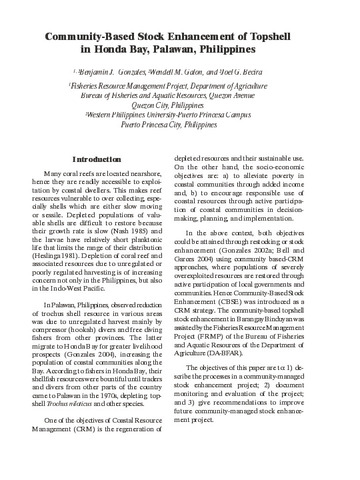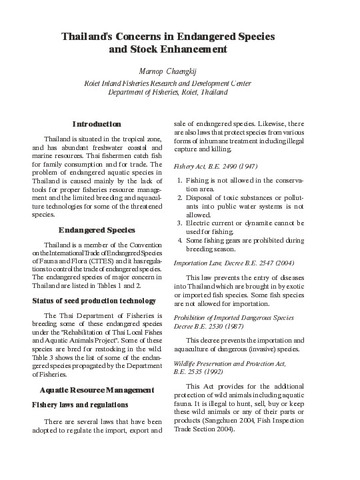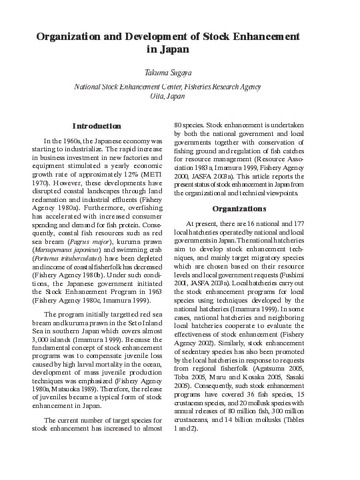Community-based stock enhancement of topshell in Honda Bay, Palawan, Philippines
Share
Abstract
In Palawan, Philippines, observed reduction of trochus shell resource in various areas was due to unregulated harvest mainly by compressor (hookah) divers and free diving fishers from other provinces. The latter migrate to Honda Bay for greater livelihood prospects (Gonzales, 2004), increasing the population of coastal communities along the Bay. According to fishers in Honda Bay, their shellfish resources were bountiful until traders and divers from other parts of the country came to Palawan in the 1970s, depleting topshell Trochus niloticus and other species. One of the objectives of Coastal Resource Management (CRM) is the regeneration of depleted resources and their sustainable use. On the other hand, the socio-economic objectives are: a) to alleviate poverty in coastal communities through added income and, b) to encourage responsible use of coastal resources through active participation of coastal communities in decision-making, planning, and implementation. The community-based topshell stock enhancement in Barangay Binduyan was assisted by the Fisheries Resource Management Project (FRMP) of the Bureau of Fisheries and Aquatic Resources of the Department of Agriculture (DA-BFAR). The objectives of this paper are to: 1) describe the processes in a community-managed stock enhancement project; 2) document monitoring and evaluation of the project; and 3) give recommendations to improve future community-managed stock enhancement project.
Suggested Citation
Gonzales, B. J., Galon, W. M., & Becira, J. G. (2006). Community-based stock enhancement of topshell in Honda Bay, Palawan, Philippines. In J. H. Primavera, E. T. Quinitio, & M. R. R. Eguia (Eds.), Proceedings of the Regional Technical Consultation on Stock Enhancement for Threatened Species of International Concern, Iloilo City, Philippines, 13-15 July 2005 (pp. 49-59). Tigbauan, Iloilo, Philippines: Aquaculture Department, Southeast Asian Fisheries Development Center.
Subject
mollusc culture  ; marine molluscs
; marine molluscs  ; stock assessment
; stock assessment  ; stocks
; stocks  ; stocking (organisms)
; stocking (organisms)  ; User participation; Participatory approach; community planning
; User participation; Participatory approach; community planning  ; resource conservation
; resource conservation  ; resource management
; resource management  ; nature conservation
; nature conservation  ; Protected resources; threatened species
; Protected resources; threatened species  ; sustainability
; sustainability  ; sustainable development
; sustainable development  ; Philippines; Trochus niloticus
; Philippines; Trochus niloticus
 ; marine molluscs
; marine molluscs  ; stock assessment
; stock assessment  ; stocks
; stocks  ; stocking (organisms)
; stocking (organisms)  ; User participation; Participatory approach; community planning
; User participation; Participatory approach; community planning  ; resource conservation
; resource conservation  ; resource management
; resource management  ; nature conservation
; nature conservation  ; Protected resources; threatened species
; Protected resources; threatened species  ; sustainability
; sustainability  ; sustainable development
; sustainable development  ; Philippines; Trochus niloticus
; Philippines; Trochus niloticus
Related items
Showing items related by title, author, creator and subject.
-
Thailand's concerns in endangered species and stock enhancement
Chaengkij, Marnop (Aquaculture Department, Southeast Asian Fisheries Development Center, 2006)The paper provides a comprehensive list of endangered freshwater, brackishwater, and marine aquatic species in Thailand. The Thai Department of Fisheries is breeding some of the endangered species under the “Rehabilitation ... -
Organization and development of stock enhancement in Japan
Sugaya, Takuma (Aquaculture Department, Southeast Asian Fisheries Development Center, 2006)In the 1960s, the Japanese economy was starting to industrialize. The rapid increase in business investment in new factories and equipment stimulated a yearly economic growth rate of approximately 12% (METI 1970). However, ... -
Aquaculture-based Enhancement and Restoration of Giant Clam in Thailand
Nugranad, Jintana; Kittiwattanawong, Kongkiat (Training Department, Southeast Asian Fisheries Development Center, 2016)Giant clams are protected species under Thailand's Wildlife Conservation and Protection Act of B.E. 2535. Natural stock of giant clams has been declining to scarcity in almost every natural distribution area. Among three ...




